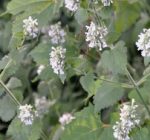 Native to Eurasia, this short lived herbaceous perennial is also known as catmint and is a member of the mint family, Labiaceae, that also includes rosemary, basil, and beebalm. Plants grow 2-4′ tall and spread up to 6′ wide. The upright reddish-brown stems carry narrow leaves up to four inches long. The leaves have deep finger-like lobes with green top sides and silver bottom sides covered with fuzzy white hairs. Leafy clusters of small yellow-green flowers appear from late summer into fall at the stem tips and leaf axils and are attractive to butterflies and bees. Plants are coarse and not particularly ornamental but are well worth growing for their leaves which when dried stimulate about 70% of domestic and wild cats to amusing antics. The genus name, Nepeta, proabably honors Nepe, an ancient Etruscan city now known as Tuscia in Lazio, Italy, an area where the plant grows abundantly. The specific epithet, cataria, is derived from the Latin word catus, meaning cat, and refers to the attraction that cats have for the plant.
Native to Eurasia, this short lived herbaceous perennial is also known as catmint and is a member of the mint family, Labiaceae, that also includes rosemary, basil, and beebalm. Plants grow 2-4′ tall and spread up to 6′ wide. The upright reddish-brown stems carry narrow leaves up to four inches long. The leaves have deep finger-like lobes with green top sides and silver bottom sides covered with fuzzy white hairs. Leafy clusters of small yellow-green flowers appear from late summer into fall at the stem tips and leaf axils and are attractive to butterflies and bees. Plants are coarse and not particularly ornamental but are well worth growing for their leaves which when dried stimulate about 70% of domestic and wild cats to amusing antics. The genus name, Nepeta, proabably honors Nepe, an ancient Etruscan city now known as Tuscia in Lazio, Italy, an area where the plant grows abundantly. The specific epithet, cataria, is derived from the Latin word catus, meaning cat, and refers to the attraction that cats have for the plant.
Type: Short lived herbaceous perennial
Bloom: Small (1/4-1/2”) white, tubular flowers are borne in massed spikes in summer.
Foliage: Coarse, toothed, opposite, egg-shaped, 2-3” long gray-green leaves with whitish, downy, undersides.
Size: 1-3’ H x 1-3’ W.
Light: Full sun to part shade.
Soil: Average, sandy, well drained, pH 6.6.
Hardiness: Zones 3-9.
Care: Gather leaves and tops in late summer when in full bloom and dry by hanging upside down in the shade.
Pests and Diseases: Cats can be a problem if they find a patch as they like to roll in it; none other of significance.
Propagation: Cuttings taken in spring, mid-summer, or fall; seed but cuttings easier..
